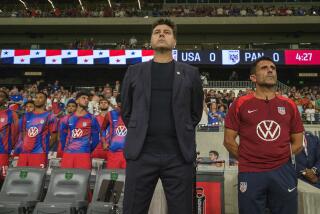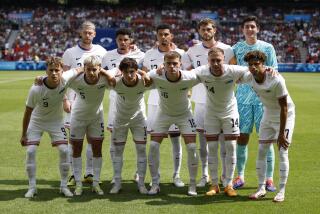WORLD CUP USA 1994 : America’s Passion Play : The United States’ Surprising Success in the First Round has Allowed Its Fans a Chance to Feel the Heat that Is Synonymous with World Cup Competition
- Share via
Channel surfers are zapping from the weather in Denver to the financial ticker to “Little House on the Prairie” reruns and are stopping to watch corner kicks and wondering when Alexi Lalas is going to host “MTV Unplugged.”
Suddenly, there seems to be room on talk radio for soccer.
True passion doesn’t necessarily bloom overnight and no one expects U.S. stock markets to close during World Cup games, like they did in Brazil. But soccer left the stadium and joined pop culture, at least temporarily, when the United States defeated Colombia, 2-1, on Wednesday in the first round of the World Cup.
Any forecast on whether the U.S. soccer team will set off a spark that turns into the vibrant flame that exists almost everywhere else in the world is premature and presumptuous, of course. But World Cup ’94 already has surpassed its pre-tournament billing as another sporting contest that was being force-fed to a reluctant public and recalcitrant media.
“The masses have it and they want it and they are doing it, but I’m not sure if the power structure is quite there,” said Martha Lopez-Garza, a sociology professor at Occidental College. “I’m not convinced yet.”
Power structures, in this case possible sponsors, advertising executives and the media, might rely on raw data, but passion and emotion aren’t easily measured, not always fitting into neat little categories on flow charts. No one was on hand to poll the fans who staged a spur-of-the-moment celebration Wednesday night at a Yorba Linda gas station when goalkeeper Tony Meola and defender Marcelo Balboa stopped for a bathroom break on their way back to Dana Point, serenading them with cheers of “U-S-A! U-S-A!”
Then there were the fans with patriotic makeup--red, white and blue faces--clad in flags, wandering the streets of Pasadena, slowing traffic long after the game ended on Wednesday night.
Or how about the afterglow lasting through the rest of the week. Lalas combed through a pile of fan mail on Friday while doing interviews. At the team’s resort hotel in Dana Point, a solid line of television trucks lined the entrance on Thursday. The proliferation of satellite dishes made the parking area look like a mushroom farm.
“There were more one-on-one interviews in one day than in the last 15 months combined,” said agent Leigh Steinberg, who is representing the U.S. team.
U.S. Coach Bora Milutinovic, a man of the world in the truest sense, has been getting calls in every language. Except he is trying to convince some of his friends that, yes, the Americans did win, 2-1. No, it was not a misprint.
In Dallas, officials of soccer’s governing body, FIFA, were stunned. Already, the warm reception the World Cup has received in the United States had allayed FIFA’s fears that Americans would not give the event its due respect.
“I have been in football 19 years as an executive, and I have never (seen) this feeling of emotion, and the awareness of our games as we’ve had in the United States,” said Joseph Blatter, secretary general of FIFA.
“They proved that this game has a right to have its place in the U.S.”
Two days after the victory, Chief Sebastian Babatunde Williams of Nigeria still could not believe what had happened.
“Now (Americans) started reacting to it,” he said. “And they are enjoying it. I see the expression on their faces. When I get in a cab, the driver wants to talk about soccer.”
Said World Cup ’94 chairman Alan Rothenberg: “The response has been overwhelming. People are walking by and high-fiving us as we’re traveling around, getting in and out of cabs and at airports.”
Steinberg pointed out the importance of today’s game against Romania from a television standpoint, since it is on ABC, and is only days after the upset of Colombia. Wednesday’s U.S.-Colombia game drew a 4.3 national Nielsen rating for ESPN. In contrast, Game 7 of the Stanley Cup finals between the New York Rangers and the Vancouver Canucks drew a 5.2. But ESPN’s opening-day baseball game between the Cincinnati Reds and St. Louis Cardinals received a 4.1, the cable network’s best rating of the season for baseball.
Jack O’Hara, executive producer of ABC sports, refused to make any predictions for today’s U.S.-Romania game.
“I refused to make any ratings guesses before the World Cup and I’m glad I did because I would have been way off,” he said. “But I will say it should be a huge rating. All the conditions are right. It’s a Sunday afternoon game facing little competition.”
Lopez-Garza of Occidental has students who were passionate about soccer long before this World Cup tournament and could get their fix only from Spanish-language Univision. Some were from places such as Armenia and Cameroon and didn’t care if they couldn’t understand a word during the games. (Univision drew a 19.1 rating among its households for the U.S.-Colombia game).
“The whole world plays,” she said. “Soccer in the United States was almost like the way we treated the metric system. We resisted it when it came up.
“It’s a very active sport. It doesn’t seem to be as violent as some sports, especially for kids. It’s a lot more exciting than baseball.
“As a society, we like to be ahead. We don’t like to be last on the bus or last at a party. We said, ‘It’s not our game. Everybody else is already doing it.’ ”
Corporate and media resistance to soccer in the United States was noticeable before the World Cup landed here. Guillermo Canedo of Mexico, FIFA’s senior vice president, recalled when only he and Joao Havelange of Brazil, FIFA’s president, supported the idea of bringing the World Cup finals to the United States.
“The old people didn’t believe football could make it here,” said Canedo, chairman of the World Cup finals organizing committee.
If anyone had reason to be skeptical, it was Canedo, a former part-owner of the Los Angeles Aztecs and the San Diego Toros, now defunct professional teams.
“But we knew exactly what could happen,” Canedo said. “Americans understand this sport like people in my country. How many millions of Americans are from Europe and the Americas? The immigration is tremendous. These people are going to fill these stadiums and bring their American friends. They are going to be the teachers.
“When the next league begins, well, that is the moment for change in the United States.”
Rothenberg likes to say that the real job begins July 18, the day after the World Cup final. Blatter and his colleagues campaigned vigorously to boost the U.S. national team and bring soccer to America. They have been frustrated for years because millions of American youth played the sport, then dropped out of sight before ever buying a ticket.
Now optimism is replacing frustration and FIFA believes soccer has reached a crossroad.
“It is not like some American commentators have said, it is not a one-time event,” Blatter said. “It is a legacy, not a two-day circus. One half hour after the match (at the Rose Bowl), people were still in the stadium cheering. We have seen the United States play with such a fighting spirit, it is such a tremendous thing to see. They produce such an emotion.”
Emotions spilled over in the Rose Bowl stands, too. Generally, the crowd was well behaved and Colombians and Americans seemed to get along. Once it became clear that the United States had a decent chance of carving out a bit of soccer history, the mood got tense in one section, according to Al Mistri, who is the soccer coach at Cal State Fullerton.
“There was a fight in the section behind my wife,” he said. “I’m not sure what exactly happened, but someone got in a Colombian’s face. It’s not the kind of thing you like to see at a game. But at least someone finally gives a hoot about soccer. I feel proud. It felt really good to see.
“This is the kind of passion that only this game can produce.”
Today, the passion will play out at the Rose Bowl. Wednesday might very well have been the highlight of the ’94 World Cup tournament, but now the expectation level has been raised with the U.S. performance.
What are the chances of the passion staying alive after the World Cup?
“The bottom line is that this has helped propel us up,” Mistri said. “I may not see it. You may not see it. But your children will see it.
“Before Wednesday, I would have said no.”
*
Times staff writers Elliott Almond, Julie Cart and Larry Stewart contributed to this report.







